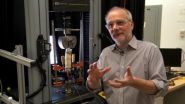(Press-News.org) Pour sand from a bucket and it flows like a liquid, but stand on it and it supports weight like a solid. This unusual behavior is a property of granular materials, and it is one of the reasons Heinrich Jaeger, the William J. and Alicia Townsend Friedman Professor in Physics at the University of Chicago, has chosen to focus on these types of materials in his research.
Jaeger will present a lecture on "Granular Matter: From Basic Questions to New Concepts and Applications," at the 2014 annual meeting of the American Association for the Advancement of Science. The talk is scheduled from noon to 1 p.m. on Friday, Feb. 14, in Regency B of the Hyatt Regency Chicago, 151 E. Upper Wacker Dr.
The subject has led his group from the basic science of granular materials to their technological applications. The study of these applications then steered them back to new basic science questions. In his talk, Jaeger will highlight the cyclical nature of his process. "It's not just a one-way street or even a two-way street, but it's really a circular thing," said Jaeger.
Granular materials are special because they are non-equilibrium materials—unlike crystalline materials, they will never be able to reach their optimal state of packing. "It's kind of the prototypical material that cannot find its sweet spot," Jaeger said. Granular materials have been used as a model system to help scientists study materials that behave similarly, like glass, which is structurally like a liquid, but behaves like a solid.
The group has been studying a property called "jamming," which describes the transition from liquid- to solid-like behavior in granular material. A traffic jam is one familiar example of this phenomenon—cars will flow smoothly until a phase transition occurs, and gridlock descends.
This basic science has led the group to new applications for these materials. Jaeger will discuss his group's collaborative work with robotics developers toward integrating the property of jamming in robots. Robots are typically made of rigid structures, but jamming robots can become soft, reshape themselves, and become hard again. One application the group has worked on is a robotic gripper. Instead of stiff fingers, which may have trouble grasping complex shapes, a soft gripper can be used to mold around an object, and jamming can then be induced to tighten its grip.
The question of how to optimize materials for use in applications like these brought Jaeger's group again back to fundamental science. They realized that scientists knew how to go from the properties of individual particles to the behavior of the granular material made up of those particles, but they didn't know how to start with a desired behavior from a material—for example, a material which is strong under compression—and determine how to design the particles to get that result.
To understand how to solve this problem for granular materials—and for materials science problems in general—Jaeger's group is now working with evolutionary algorithms, using computers to model evolutionary-type processes to generate the optimal particle shape for a given application.
"All of this came out of essentially a basic fundamental quest to understand a glass transition," Jaeger said.—Emily Conover
INFORMATION:
Heinrich Jaeger to discuss physics of granular materials at AAAS meeting
2014-02-15
ELSE PRESS RELEASES FROM THIS DATE:
Growing number of chemicals linked with brain disorders in children
2014-02-15
Boston, MA – Toxic chemicals may be triggering the recent increases in neurodevelopmental disabilities among children—such as autism, attention-deficit hyperactivity disorder, and dyslexia—according to a new study from Harvard School of Public Health (HSPH) and Icahn School of Medicine at Mount Sinai. The researchers say a new global prevention strategy to control the use of these substances is urgently needed.
The report will be published online February 15, 2014 in Lancet Neurology.
"The greatest concern is the large numbers of children who are affected by toxic damage ...
Tired all the time: Could undiagnosed sleep problems be making MS patients' fatigue worse?
2014-02-15
ANN ARBOR, Mich. — People with multiple sclerosis (MS) might assume that the fatigue they often feel just comes with the territory of their chronic neurological condition.
But a new University of Michigan study suggests that a large proportion of MS patients may have an undiagnosed sleep disorder that is also known to cause fatigue. And that disorder – obstructive sleep apnea – is a treatable condition.
In the latest issue of the Journal of Clinical Sleep Medicine, researchers from the U-M Health System's Sleep Disorders Center report the results of a study involving ...
Can citrus ward off your risk of stroke?
2014-02-15
PHILADELPHIA – Eating foods that contain vitamin C may reduce your risk of the most common type of hemorrhagic stroke, according to a study released today that will be presented at the American Academy of Neurology's 66th Annual Meeting in Philadelphia, April 26 to May 3, 2014.
Vitamin C is found in fruits and vegetables such as oranges, papaya, peppers, broccoli and strawberries. Hemorrhagic stroke is less common than ischemic stroke, but is more often deadly.
The study involved 65 people who had experienced an intracerebral hemorrhagic stroke, or a blood vessel rupture ...
Cognitive behavioral therapy for insomnia can reduce health care utilization and costs
2014-02-15
DARIEN, IL – A new study is the first to show decreases in health care utilization and costs following brief treatment with cognitive behavioral therapy for insomnia (CBTI).
Results show that sleep improved in 86 percent of insomnia patients who completed at least three sessions of CBTI. In the six months following treatment, health care utilization decreased and health care-related costs were reduced by more than $200 on average among treatment completers.
"Cognitive behavioral therapy for insomnia is a highly effective treatment, and this study shows that a relatively ...
Is truth stranger than fiction? Yes, especially for science fiction
2014-02-15
CHICAGO – From warp drives to hyperspace, science fiction has continuously borrowed from, and sometimes anticipated, the state of the art in scientific progress. This has resulted in the perception that science and science fiction have a causal relationship, one finding direction from and fulfilling the science fantasy laid out before it.
But that is rarely the case, according to Lawrence Krauss, a Foundation professor in the School of Space and Earth Exploration and the Department of Physics at Arizona State University. No doubt, science fiction has taken inspiration ...
Citizenship education goes digital
2014-02-15
WACO, Texas (Feb. 14, 2014) --Can playing online video games help students learn civics education? According to Baylor University researchers, the answer is yes.
Brooke Blevins, Ph.D., assistant professor of curriculum and instruction and Karon LeCompte, Ph.D., assistant professor of curriculum and instruction in Baylor's School of Education studied the effectiveness of iCivics, a free online website founded by retired Supreme Court Justice Sandra Day O'Connor that teaches civics concepts using 19 educational games.
The study, published in The Journal of Social Studies ...
Scripps researchers recommend mobile compression device to prevent DVT after joint surgery
2014-02-15
LA JOLLA, Calif. – Research from The Shiley Center for Orthopaedic Research and Education at Scripps Clinic could change how patients are treated to prevent blood clots after joint replacement surgery. A study published as the lead article in the current issue of the Journal of Bone and Joint Surgery determined that after lower extremity joint replacement surgery a mobile compression device was just as effective as blood thinners in preventing deep vein thrombosis (DVT), but without negative side effects including bleeding complications.
The multicenter study, led by ...
Clinical trial success influenced by biomarker- and receptor-targeted therapies in NSCLC
2014-02-15
DENVER – Over the past decade, a great clinical focus has been directed at developing new and innovative therapies for advanced non-small cell lung cancer (NSCLC). An analysis of clinical trials evaluating these therapies demonstrates that the cumulative success rate for new agents for advanced NSCLC is lower than the industry-estimated rate. However, biomarker- and receptor-targeted therapies were found to substantially increase clinical trial success.
The analysis was designed to evaluate the risk of clinical trial failure in advanced (stage IIIb-IV) NSCLC drug development ...
High frequency of EGFR mutations found in Asian population
2014-02-15
DENVER – Adenocarcinoma histology, female sex, never-smoking status, and Asian ethnicity have been considered the most important factors associated with EGFR mutations in non-small cell lung cancer and response to EGFR inhibitors. A recent study has found that, within the Asian population, the frequency of EGFR mutations associated with other demographic and clinical characteristics is higher than previously reported, even in patients with a history of smoking, suggesting that mutation testing should be done on a broader basis among Asian patients with advanced adenocarcinoma ...
MLB largely responsible for players' steroid abuse, UTA researcher says
2014-02-15
The widespread use of illegal steroids among Major League Baseball players has been fueled by an "economy of bodily management," the free agent market and exploding television revenues, a UT Arlington assistant professor argues in a newly published research paper.
Sarah Rose, a labor and disability historian, says by attacking individual ballplayers' morality, commentators have obscured the more salient issue.
"Baseball is representative of the fact that Americans increasingly live in an age of biotechnology in which bodily modification for profit has become the norm ...


